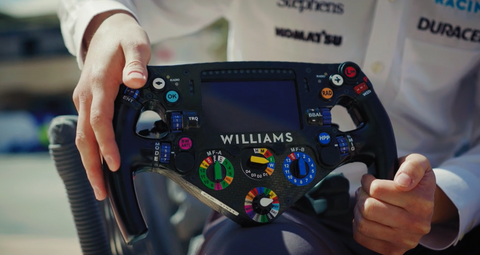Since 2015, the team has utilized a wheel with the dashboard mounted to the chassis rather than the wheel itself. This design choice was influenced by several factors, including driver preference and the desire to reduce the weight of the wheel. However, with evolving car designs and changing driver requirements, Williams has transitioned to a new design, integrating the dashboard directly into the wheel.

That change is costly, so it took time to transition the manufacturing processes as well as the electronics and software needed to run the screen reliably. If the wheel malfunctions or the display goes dark during a race in a modern F1 car, it is pretty much the end of the race - a far cry from the 90s and 2000s F1. You do not need to look far to find multiple such failures - Max Verstappen's Redbull in the 2021 Turkish Gran Prix for example.
Throughout the design process, a multitude of individuals from various departments within the company, including designers, electronics engineers, systems engineers, trackside engineers, and the drivers themselves, collaborated to create a bespoke solution tailored to the needs of both drivers for the current season.
This new design ensures that the dashboard remains visible to the driver at all times, even during high-speed corners, allowing for quick reference to switch settings. The ergonomic layout of the wheel features strategically placed buttons, enabling the driver to access controls effortlessly with a thumb movement. Rotaries and switches located on the wheel allow for on-the-fly adjustments to various car settings, enhancing performance corner by corner and lap after lap.
Additionally, the back of the wheel features important components such as paddles for starts and toggles for specific corner setups, catering to individual driver preferences. Each driver receives a customized wheel with unique button configurations and LED lights tailored to their preferences, ensuring optimal comfort and functionality.
While the wedge shape does not look as pleasing as most other F1 wheels, the logic is clear - less material, less weight and more handling space for the drivers. It is often overlooked how tight the space actually is for drivers hands - there are even tiny cutouts on the cockpit cover so the hands can move out when the wheel is turned more than just a few degrees.

A significant aspect of the design process was ensuring that the wheel provided a comfortable grip for the drivers, achieved through bespoke grip moldings. This also was a driving factor for us to use molded grips on our F1L Series 2 wheel. While leather and Alcantara wrapped grips look and feel wonderful, the complexity of the grip shape makes a wrinkle free and seamfree covering with such materials simply not possible.

Overall, a considerable amount of effort has been invested in the development of this new wheel, and even as one of the smaller teams, the efforts and finances for such a team cannot be understated. So we are looking forward to see Williams Racing in action on the track and climb up the mid field for 2024.


